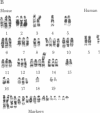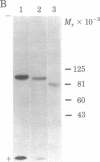Abstract
Human chromosome 3 has been identified as responsible for expression of the transferrin receptor in mouse-human lymphocyte hybrids. The receptor was detected by immunoprecipitation with anti-human receptor antibody of 125I-labeled cells. This method also detected a similar 94,000-dalton protein in mouse cells. A radioimmunoassay developed for the human transferrin receptor measured 10% crossreactivity with the mouse protein. The two proteins were distinguished by NaDodSO4/polyacrylamide gel patterns of partial proteolytic digests of the immunoprecipitated proteins. Mouse-human hybrids were generated by fusing a mouse thymoma (BW5147) cell line to either concanavalin A- or pokeweed mitogen-activated human peripheral blood lymphocytes or a mouse myeloma (NS-1) to uncultured human peripheral blood lymphocytes. Each hybrid was karyotyped with respect to both mouse and human chromosomes. In every case, expression of the human transferrin receptor correlated only with human chromosome 3.
Full text
PDF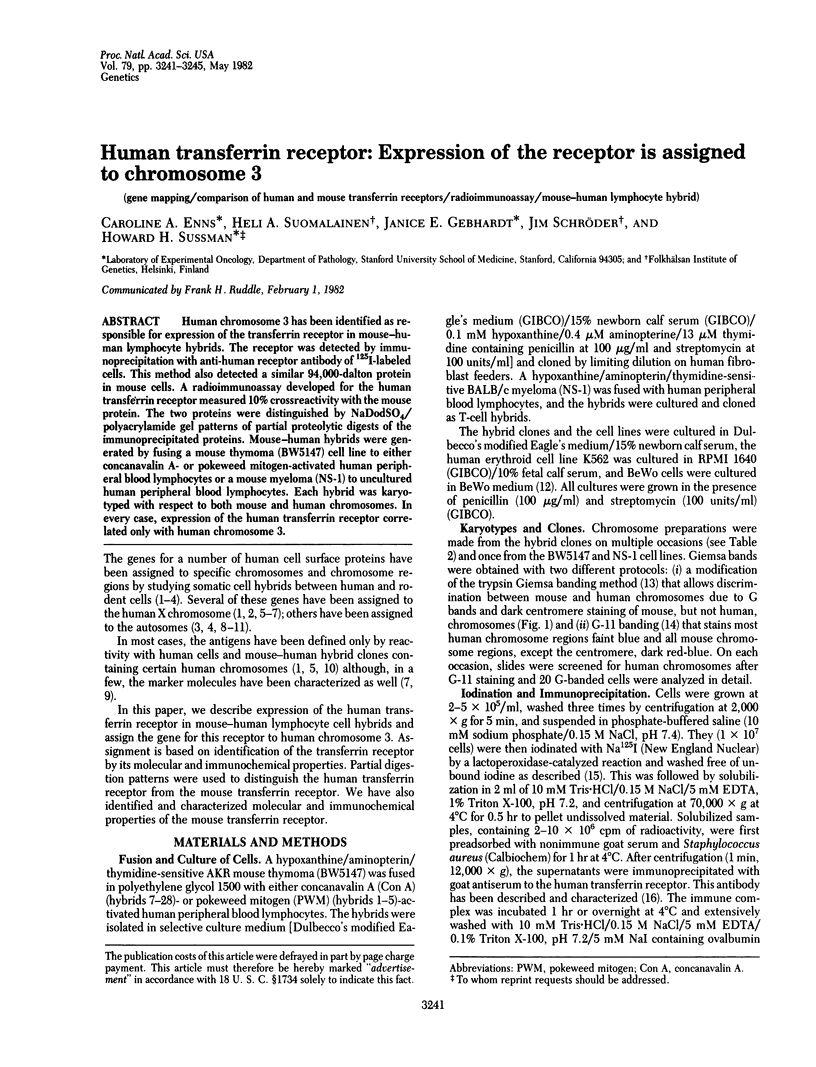
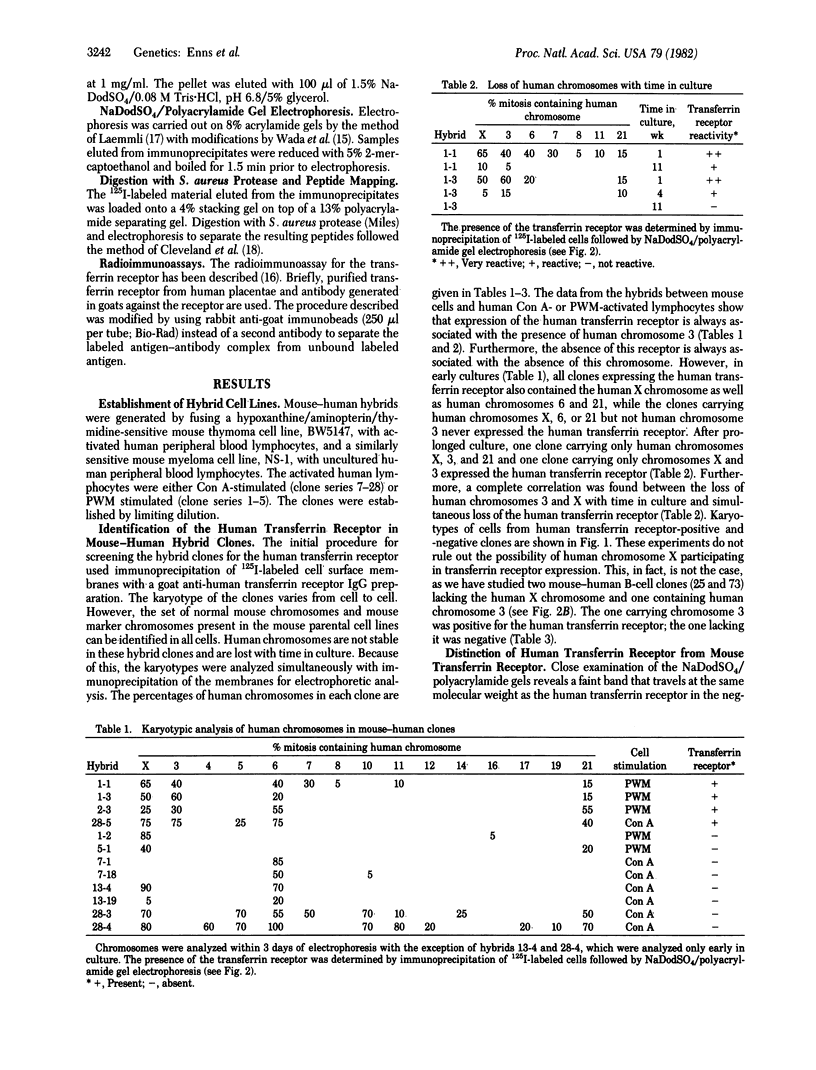
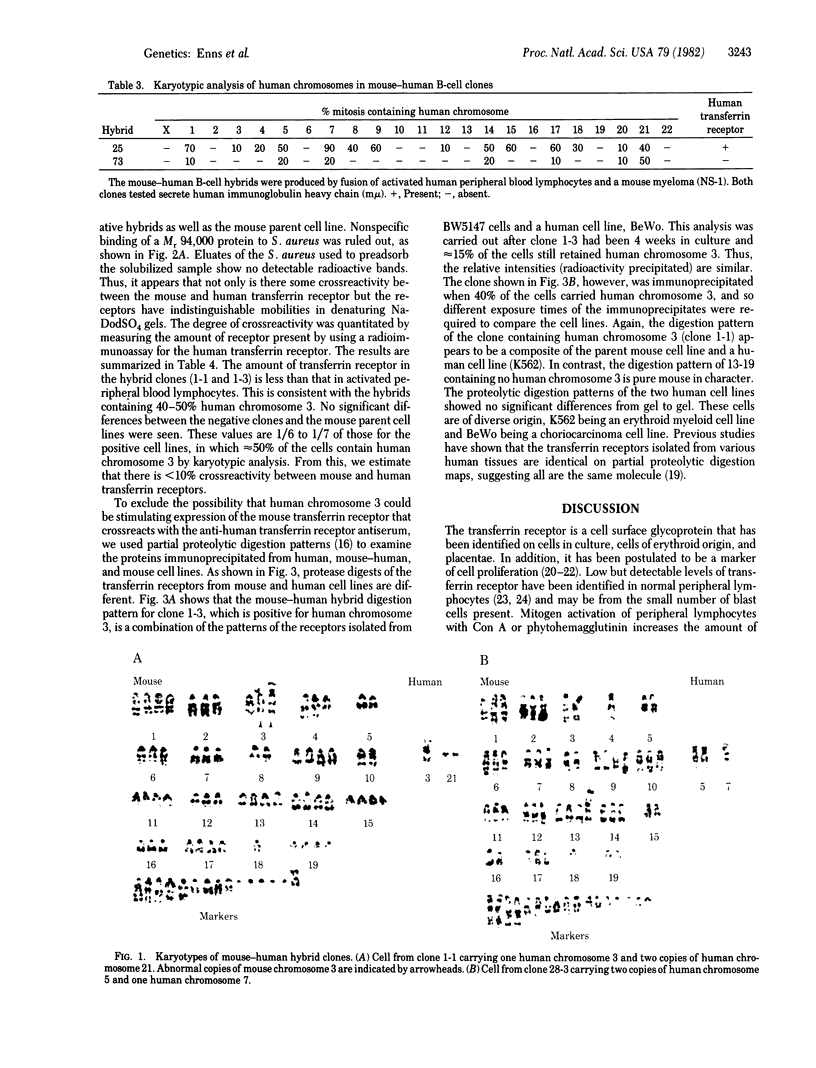
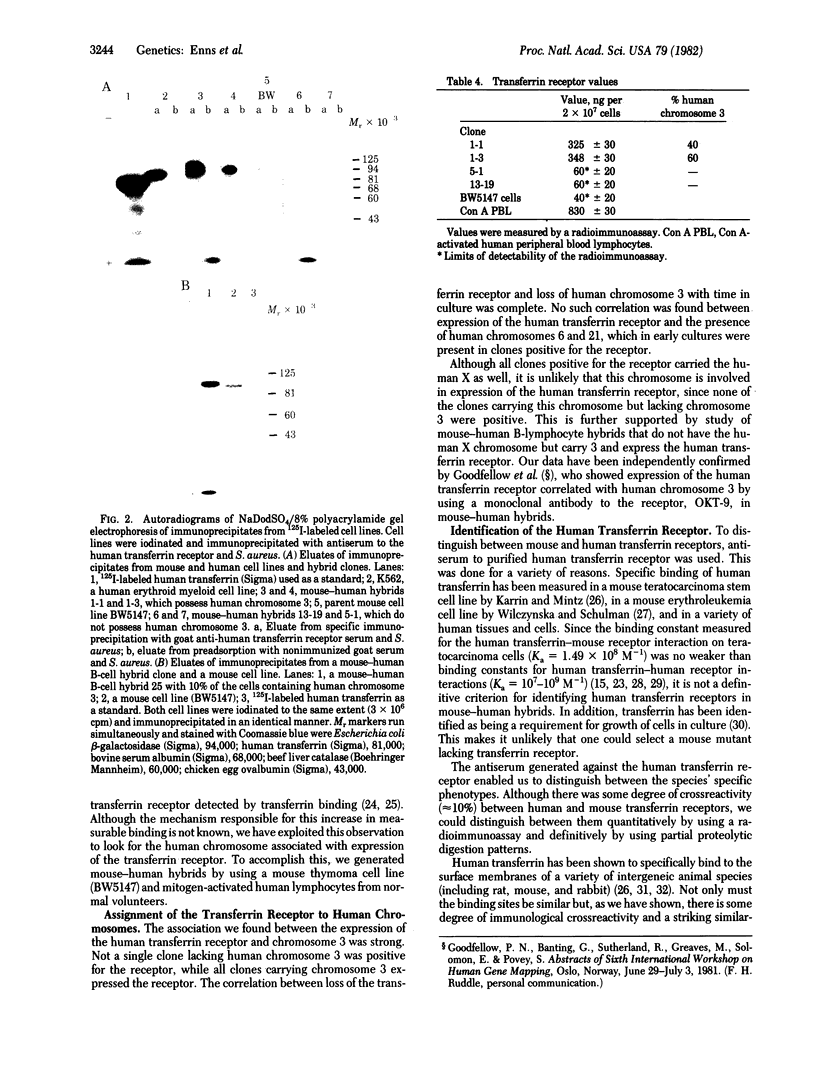
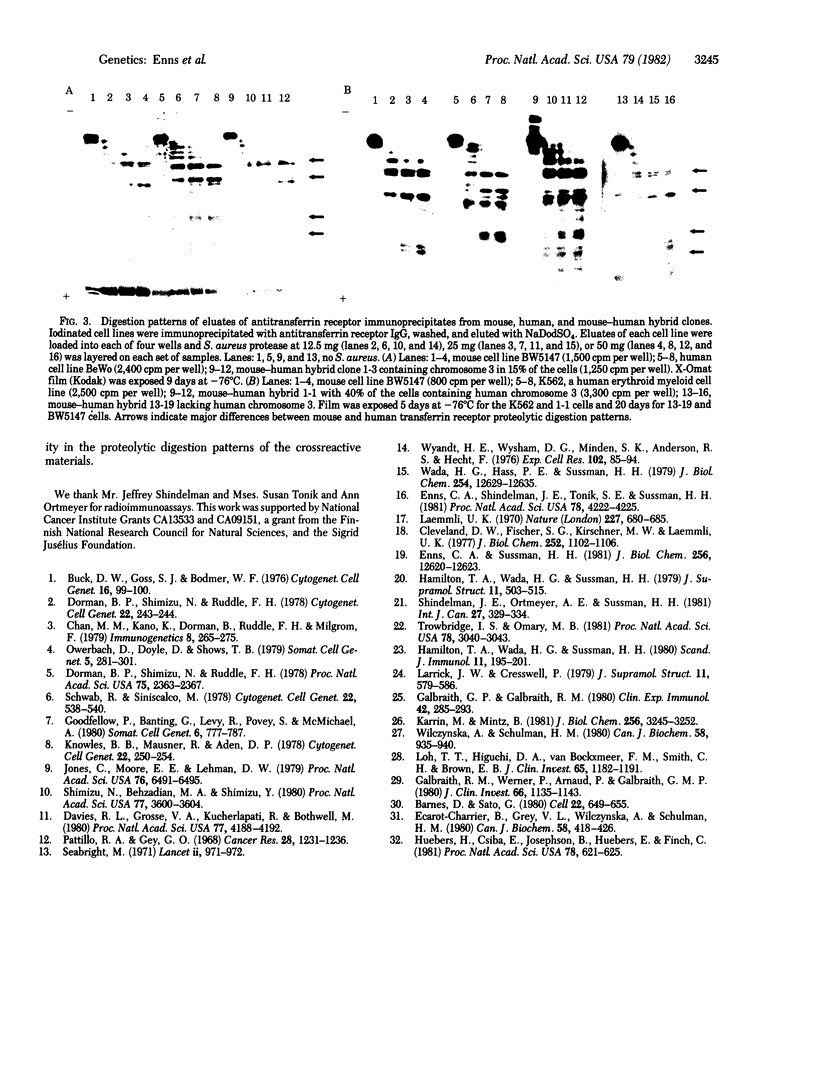
Images in this article
Selected References
These references are in PubMed. This may not be the complete list of references from this article.
- Barnes D., Sato G. Serum-free cell culture: a unifying approach. Cell. 1980 Dec;22(3):649–655. doi: 10.1016/0092-8674(80)90540-1. [DOI] [PubMed] [Google Scholar]
- Buck D. W., Goss S. J., Bodmer W. F. Regional mapping of the X-linked gene for a human cell surface antigen, SA-X. Cytogenet Cell Genet. 1976;16(1-5):99–100. doi: 10.1159/000130563. [DOI] [PubMed] [Google Scholar]
- Cleveland D. W., Fischer S. G., Kirschner M. W., Laemmli U. K. Peptide mapping by limited proteolysis in sodium dodecyl sulfate and analysis by gel electrophoresis. J Biol Chem. 1977 Feb 10;252(3):1102–1106. [PubMed] [Google Scholar]
- Davies R. L., Grosse V. A., Kucherlapati R., Bothwell M. Genetic analysis of epidermal growth factor action: assignment of human epidermal growth factor receptor gene to chromosome 7. Proc Natl Acad Sci U S A. 1980 Jul;77(7):4188–4192. doi: 10.1073/pnas.77.7.4188. [DOI] [PMC free article] [PubMed] [Google Scholar]
- Dorman B. P., Shimizu N., Ruddle F. H. A cell surface antigen linked to the human X chromosome and present on fibroblasts. Cytogenet Cell Genet. 1978;22(1-6):243–244. doi: 10.1159/000130946. [DOI] [PubMed] [Google Scholar]
- Dorman B. P., Shimizu N., Ruddle F. H. Genetic analysis of the human cell surface: antigenic marker for the human X chromosome in human-mouse hybrids. Proc Natl Acad Sci U S A. 1978 May;75(5):2363–2367. doi: 10.1073/pnas.75.5.2363. [DOI] [PMC free article] [PubMed] [Google Scholar]
- Ecarot-Charrier B., Grey V. L., Wilczynska A., Schulman H. M. Reticulocyte membrane transferrin receptors. Can J Biochem. 1980 May;58(5):418–426. doi: 10.1139/o80-055. [DOI] [PubMed] [Google Scholar]
- Enns C. A., Shindelman J. E., Tonik S. E., Sussman H. H. Radioimmunochemical measurement of the transferrin receptor in human trophoblast and reticulocyte membranes with a specific anti-receptor antibody. Proc Natl Acad Sci U S A. 1981 Jul;78(7):4222–4225. doi: 10.1073/pnas.78.7.4222. [DOI] [PMC free article] [PubMed] [Google Scholar]
- Enns C. A., Sussman H. H. Similarities between the transferrin receptor proteins on human reticulocytes and human placentae. J Biol Chem. 1981 Dec 25;256(24):12620–12623. [PubMed] [Google Scholar]
- Galbraith G. M., Galbraith R. M. Metabolic and cytoskeletal modulation of transferrin receptor mobility in mitogen-activated human lymphocytes. Clin Exp Immunol. 1980 Nov;42(2):285–293. [PMC free article] [PubMed] [Google Scholar]
- Galbraith R. M., Werner P., Arnaud P., Galbraith G. M. Transferrin binding to peripheral blood lymphocytes activated by phytohemagglutinin involves a specific receptor. Ligand interaction. J Clin Invest. 1980 Nov;66(5):1135–1143. doi: 10.1172/JCI109943. [DOI] [PMC free article] [PubMed] [Google Scholar]
- Goodfellow P., Banting G., Levy R., Povey S., McMichael A. A human X-linked antigen defined by a monoclonal antibody. Somatic Cell Genet. 1980 Nov;6(6):777–787. doi: 10.1007/BF01538976. [DOI] [PubMed] [Google Scholar]
- Hamilton T. A., Wada H. G., Sussman H. H. Expression of human placental cell surface antigens on peripheral blood lymphocytes and lymphoblastoid cell lines. Scand J Immunol. 1980;11(2):195–201. doi: 10.1111/j.1365-3083.1980.tb00227.x. [DOI] [PubMed] [Google Scholar]
- Hamilton T. A., Wada H. G., Sussman H. H. Human placental cell surface antigens:expression by cultured cells of diverse phenotypic origin. J Supramol Struct. 1979;11(4):503–515. doi: 10.1002/jss.400110409. [DOI] [PubMed] [Google Scholar]
- Huebers H., Csiba E., Josephson B., Huebers E., Finch C. Interaction of human diferric transferrin with reticulocytes. Proc Natl Acad Sci U S A. 1981 Jan;78(1):621–625. doi: 10.1073/pnas.78.1.621. [DOI] [PMC free article] [PubMed] [Google Scholar]
- Jones C., Moore E. E., Lehman D. W. Genetic and biochemical analysis of the a1 cell-surface antigen associated with human chromosome 11. Proc Natl Acad Sci U S A. 1979 Dec;76(12):6491–6495. doi: 10.1073/pnas.76.12.6491. [DOI] [PMC free article] [PubMed] [Google Scholar]
- Karin M., Mintz B. Receptor-mediated endocytosis of transferrin in developmentally totipotent mouse teratocarcinoma stem cells. J Biol Chem. 1981 Apr 10;256(7):3245–3252. [PubMed] [Google Scholar]
- Knowles B. B., Mausner R., Aden D. P. Preliminary characterization of human cell surface molecules controlled by human chromosomes 6 and 7. Cytogenet Cell Genet. 1978;22(1-6):250–254. doi: 10.1159/000130948. [DOI] [PubMed] [Google Scholar]
- Laemmli U. K. Cleavage of structural proteins during the assembly of the head of bacteriophage T4. Nature. 1970 Aug 15;227(5259):680–685. doi: 10.1038/227680a0. [DOI] [PubMed] [Google Scholar]
- Larrick J. W., Cresswell P. Modulation of cell surface iron transferrin receptors by cellular density and state of activation. J Supramol Struct. 1979;11(4):579–586. doi: 10.1002/jss.400110415. [DOI] [PubMed] [Google Scholar]
- Pattillo R. A., Gey G. O. The establishment of a cell line of human hormone-synthesizing trophoblastic cells in vitro. Cancer Res. 1968 Jul;28(7):1231–1236. [PubMed] [Google Scholar]
- Schwab R., Siniscalco M. Confirmative evidence for a human X-linked surface antigen and its tentative regional assignment. Cytogenet Cell Genet. 1978;22(1-6):538–540. doi: 10.1159/000131019. [DOI] [PubMed] [Google Scholar]
- Seabright M. A rapid banding technique for human chromosomes. Lancet. 1971 Oct 30;2(7731):971–972. doi: 10.1016/s0140-6736(71)90287-x. [DOI] [PubMed] [Google Scholar]
- Shimizu N., Behzadian M. A., Shimizu Y. Genetics of cell surface receptors for bioactive polypeptides: binding of epidermal growth factor is associated with the presence of human chromosome 7 in human-mouse cell hybrids. Proc Natl Acad Sci U S A. 1980 Jun;77(6):3600–3604. doi: 10.1073/pnas.77.6.3600. [DOI] [PMC free article] [PubMed] [Google Scholar]
- Shindelman J. E., Ortmeyer A. E., Sussman H. H. Demonstration of the transferrin receptor in human breast cancer tissue. Potential marker for identifying dividing cells. Int J Cancer. 1981 Mar 15;27(3):329–334. doi: 10.1002/ijc.2910270311. [DOI] [PubMed] [Google Scholar]
- Trowbridge I. S., Omary M. B. Human cell surface glycoprotein related to cell proliferation is the receptor for transferrin. Proc Natl Acad Sci U S A. 1981 May;78(5):3039–3043. doi: 10.1073/pnas.78.5.3039. [DOI] [PMC free article] [PubMed] [Google Scholar]
- Wada H. G., Hass P. E., Sussman H. H. Transferrin receptor in human placental brush border membranes. Studies on the binding of transferrin to placental membrane vesicles and the identification of a placental brush border glycoprotein with high affinity for transferrin. J Biol Chem. 1979 Dec 25;254(24):12629–12635. [PubMed] [Google Scholar]
- Wilczynska A., Schulman H. M. Friend erythroleukemia cell membrane transferrin receptors. Can J Biochem. 1980 Oct;58(10):935–940. doi: 10.1139/o80-128. [DOI] [PubMed] [Google Scholar]
- Wyandt H. E., Wysham D. G., Minden S. K., Anderson R. S., Hecht F. Mechanisms of giemsa banding of chromosomes. I. Giemsa-11 banding with azure and eosin. Exp Cell Res. 1976 Oct 1;102(1):85–94. doi: 10.1016/0014-4827(76)90302-5. [DOI] [PubMed] [Google Scholar]




